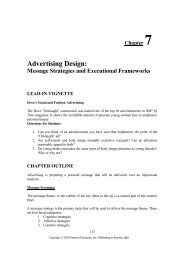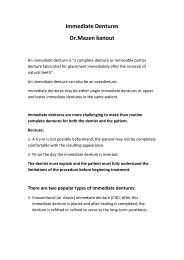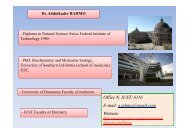pigmented lesions of oral mucosa.pdf
pigmented lesions of oral mucosa.pdf
pigmented lesions of oral mucosa.pdf
You also want an ePaper? Increase the reach of your titles
YUMPU automatically turns print PDFs into web optimized ePapers that Google loves.
Management:<br />
No treatment is requied<br />
Nevocellular Nevus and Blue Nevus<br />
ETIOLOGY<br />
nevi are due to benign proliferations <strong>of</strong> melanocytes<br />
There are two major types, based on histology, and these<br />
two types tend to show differences clinically<br />
Nevocellular nevi<br />
arise from basal-layermelanocytes<br />
Since proliferation is minimal, these nevi are macular and<br />
are classified as (junctional nevi)<br />
With time, the melanocytes form clusters<br />
at the epitheliomesenchymal junction and begin to<br />
proliferate (compound nevi)<br />
The second type <strong>of</strong> nevus, not derived from basal-layer<br />
melanocytes, is the blue nevus<br />
neither the ordinary nor the cellular form has the potential<br />
to become a melanoma<br />
Clinical features<br />
both nevocellular and blue nevi tend<br />
to be brown and may be macular or nodular,sharply-defined<br />
border .<br />
Less than 0.5 CM in size<br />
The most common sites : the palate and gingiva but may<br />
also be encountered in the buccal <strong>mucosa</strong> and on the lips.<br />
Diagnosis: Biopsy<br />
Management: Excisional biopsy<br />
Malignant Melanoma<br />
ETIOLOGY<br />
There are no known predisposing factors for intra<strong>oral</strong> melanoma<br />
Mucosal melanomas are extremely rare.









